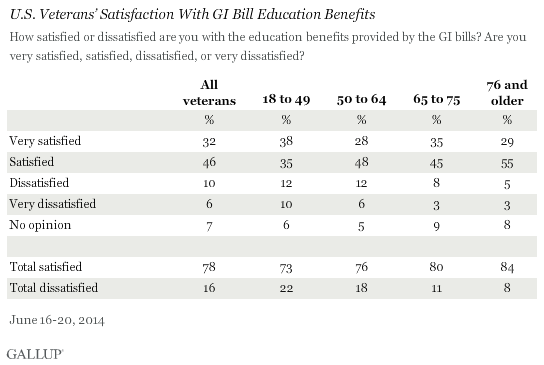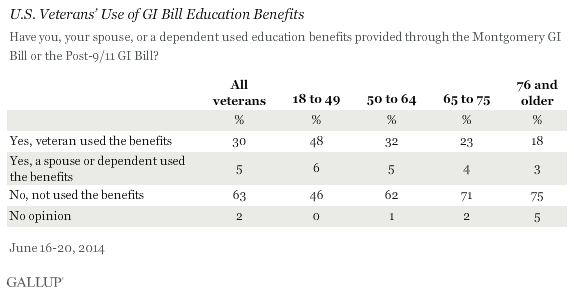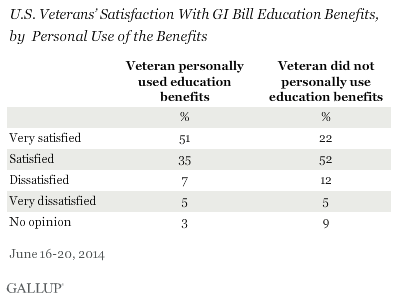This article is part of a weeklong series analyzing the veteran experience in the United States, especially how returning veterans transition from the military to civilian life.
PRINCETON, NJ -- As the original GI Bill turns 70, Gallup finds nearly eight in 10 American veterans saying they are "very satisfied" (32%) or "satisfied" (46%) with the education benefits the bills provide. Relatively few -- 16% -- are dissatisfied to any degree.

While older veterans may be answering in terms of the GI programs available decades ago, younger veterans -- those aged 18 to 49 -- are more likely to be answering with the current programs in mind. The broad satisfaction younger veterans express toward the program comes at a time when the federal government and some states, particularly California, are peering closely into how GI education money is being spent, and not liking what they see.
Studies show that many veterans are failing to graduate from college before their money runs out. Others are financially unable to meet the GI Bill's requirement to attend college full time, pushing them into lower quality part-time programs. Still others turn to for-profit education programs that offer quick, but sometimes subpar degrees that fail to provide the academic leg-up in the workforce that veterans need.
These critiques could explain why overall satisfaction with GI education benefits is slightly lower among younger veterans than among those who served in the Korean War or during World War II: 73% of those younger than 50 are satisfied compared with 84% of those aged 76 and older. However, the percentage "very satisfied" is highest among the younger age group, indicating more intensity of opinion toward the program on their part.
Gallup's new survey of U.S. military veterans was conducted June 16-20. The 1,268 veterans included in the study were originally interviewed as part of Gallup Daily tracking between January 2011 and May 2014, and agreed to be recontacted. All of the veteran respondents identified themselves as either discharged or retired from the military.
Three in 10 Veterans Have Used the Newer GI Benefits
President Franklin D. Roosevelt signed the first GI Bill into law on June 22, 1944. Congress has since passed updated versions to help returning soldiers keep up with the rising cost of living and college tuition, including the Montgomery GI Bill in 1984 and the Post-9/11 GI Bill in 2009.
Thirty percent of all U.S. veterans today say they have personally used GI education benefits provided through either the Montgomery or Post-9/11 GI Bills. That includes nearly half of veterans between the ages of 18 and 49. And an additional 6% in this group say that a spouse or other dependent used the benefit.

Satisfaction with the government's GI education benefit is especially high among veterans who report using benefits through the Montgomery or Post-9/11 GI Bills. The slight majority of this group -- 51% -- reports being very satisfied with the benefit, with another 35% satisfied. In contrast, 22% of veterans who have not used the benefit are very satisfied with it, and another 52% are satisfied.

Bottom Line
The story of America's World War II GIs enrolling in college en masse after returning home from battle is often told in halcyon terms, as an example of a government policy success. President Barack Obama recently credited the GI Bill with helping to "lay the foundation for the largest middle class in history." Its passage reflected the strong commitment of many key individuals in and outside of Congress to prevent World War II veterans from suffering the same neglect that World War I veterans experienced a generation earlier.
That impulse likely continues to drive Obama and lawmakers to craft policy that provides veterans with sufficient means to not only survive, but thrive after serving their country, ultimately contributing to the nation's economic strength. At the same time, the government's promise of a college education is the lure that draws many men and women into the modern military. Thus, fulfilling that promise to today's veterans has strong moral implications.
While there is substantial evidence to suggest that the modern GI education benefit is far from perfect, the broad satisfaction that younger veterans express toward the benefit, and the particularly high satisfaction among veterans who have experience using the recent GI Bills, is a positive sign that the program may be achieving its goals.
Survey Methods
Results are based on telephone interviews conducted June 16-20, 2014, with a random sample of 1,268 veterans, aged 18 and older, living in all 50 U.S. states and the District of Columbia.
For results based on the total sample of veterans, the margin of sampling error is ±3.3 percentage points at the 95% confidence level.
Interviews were conducted using Gallup Daily Tracking Survey Recontact Sample. Gallup Daily Tracking Survey Recontact Sample includes respondents that previously participated in the Gallup Daily Tracking Survey, and agreed to future contact. The sample universe for this study included Gallup Daily Tracking Recontact respondents that previously reported they were veterans.
The Gallup Daily Tracking Survey uses a dual frame design with a minimum quota of 50% cellphone respondents and 50% landline respondents, with additional minimum quotas by time zone within region. Landline and cellular telephone numbers are selected using random-digit-dial methods. Landline respondents are chosen at random within each household on the basis of which member had the most recent birthday.
Data are weighted by age and gender using targets derived from the Gallup Daily Tracking Surveys for the veteran population.
In addition to sampling error, question wording and practical difficulties in conducting surveys can introduce error or bias into the findings of public opinion polls.
For more details on Gallup's polling methodology, visit www.gallup.com.
